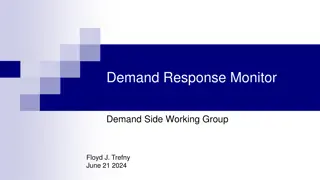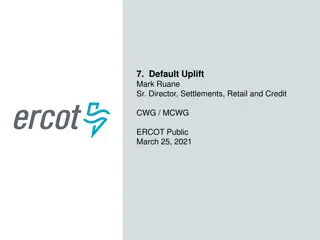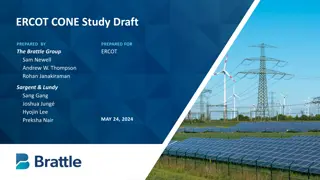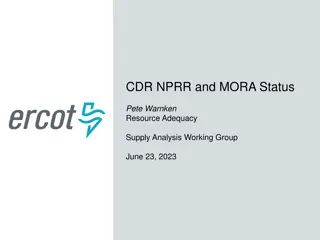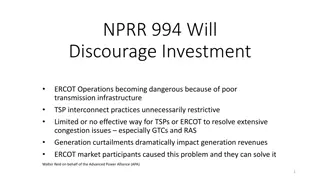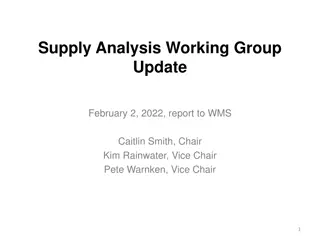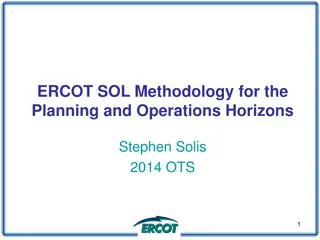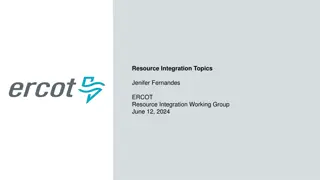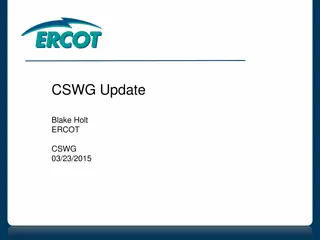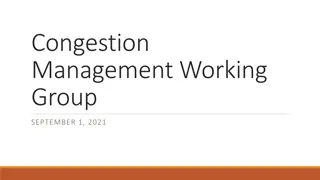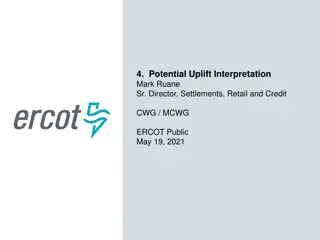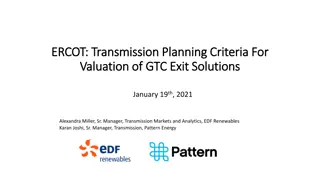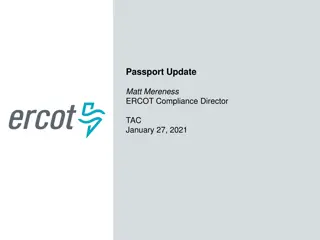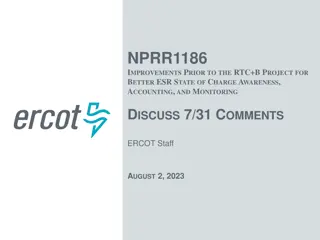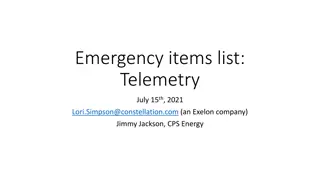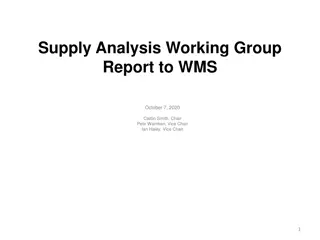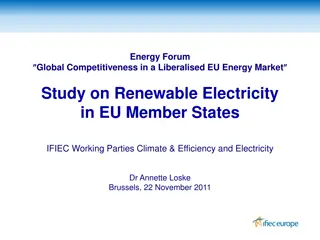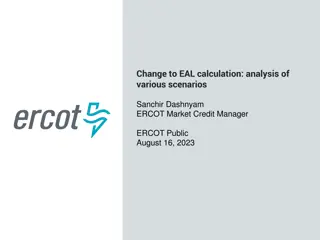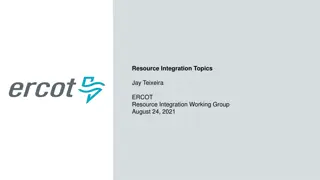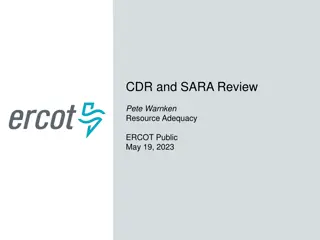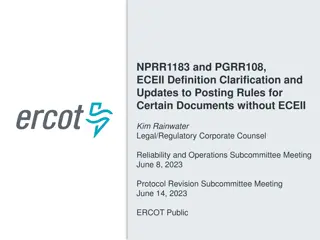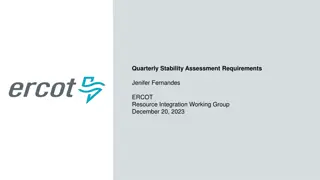Analysis of ERCOT Issues and Solutions by Luminant Energy
The analysis delves into ERCOT's identified issues and solutions regarding energy scarcity, examining historical data to pinpoint causes behind potential shortages. By reviewing specific time periods and the impact of various factors like Resource Deployment Factors (RDF) and Reserve Response Service (RRS) levels, Luminant Energy offers insights into mitigating challenges in the energy market.
Download Presentation

Please find below an Image/Link to download the presentation.
The content on the website is provided AS IS for your information and personal use only. It may not be sold, licensed, or shared on other websites without obtaining consent from the author. Download presentation by click this link. If you encounter any issues during the download, it is possible that the publisher has removed the file from their server.
E N D
Presentation Transcript
A Broad Review of August 13, 2015 and Similar Historical Situations Luminant Energy January 22, 2016
Issues Identified By ERCOT According to ERCOT s 10/29/15 Presentation to TAC (slide 3, bullet 5), which analyzed the operating day of 8/13/15: As we approach scarcity PRC will be around 2,500 and ORDC will gradually approach PRC as prices increase causing QSGRs to come online, resources to put their duct firing online and SCED to move resources to the top making the remaining capacity within 20% HSL. However, since minimum RRS level is 2,300 MW there could be situations where PRC stays just above 2,300 MW for a long time and could drop below 2,300 when we still have lot of quick starts physically offline but available to SCED. The minimum PRC that ERCOT observed that day was 2,371 MW at (~15:05) and at that time RTOLCAP was at 3,629 MW and SCED UP was 1,293 MW. This is the lowest level PRC has reached since ORDC Go Live (6/1/14 present). The difference between RTOLCAP and PRC was 1,258 MW and if all of the QSGRs had been online at HSL, then the difference would still have been ~262 MW. Since the remaining (non-QSGR) available capacity of ~262 MW is materially higher than the ~71 MW delta between PRC and the 2,300 MW EEA 1 Threshold, there are other factors contributing to the divergence of PRC and ORDC that need to be analyzed. 1
Issues Identified By ERCOT (cont.) According to ERCOT s 1/22/16 Presentation to QMWG (slide 2, bullets 3 - 5), which analyzed the operating day of 8/13/15: Sum of Reg and RRS was about 2,650 MW and these reserves were not released to SCED. A large contribution to the difference between the reserves that we procured (2,650 MW) and the measured PRC (2,371 MW) was due to use of RDF of 0.98. Using an RDF of 0.98 during the peak intervals reduced the measured PRC by more than 400 MW compared to using an RDF = 1 (no discount). Luminant Energy agrees with ERCOT s assessment that the RDF is one of the primary reasons that PRC approaches the 2,300 MW EEA 1 Threshold while un-deployed capacity remains in SCED, but it is most impactful when only 2,300 MW of RRS has been purchased. 2
Analysis performed by Luminant To better understand the underlying causes and potential solution to the issues that ERCOT identified, Luminant reviewed historical periods where PRC was within 100 MW of the EEA 1 Threshold. The following slides review three separate time periods: 4/1/11 6/30/11 (prior to Luminant offering QSGRs in SCED, RRS minimum requirement of 2,300 MW) 7/1/11 3/31/12 (Luminant offering ~1,000 MW of QSGRs in SCED, RRS minimum requirement of 2,300 MW 4/1/12 5/31/15 (Luminant offering ~1,000 MW of QSGRs in SCED, RRS minimum requirement of 2,800 MW.) The following line plots show that the exact issue that we experienced on 8/13/15 (where PRC approached EEA 1 Threshold while SCED still had un-deployed capacity) happened routinely with similar levels of un-deployed capacity during the 12 months when only 2,300 MW of RRS was purchased. However, during the 38 month period from Apr 2012 May 2015, when 2,800 MW of RRS was purchased, the issue was nearly non-existent. Thus, Luminant concludes that the RDF applied to PRC combined with the purchase of less RRS is the principal driver of the issue that ERCOT identified on August 13, 2015. 3
Review of Historical Data Where RRS = 2,300 MW During this three month period at the beginning of TX Nodal, prior to Luminant Energy offering any QSGRs into SCED, there is a tight cluster of SCED Up volumes in the range of -50 to 450 MW that could not have been impacted by LUME QSGRs in SCED The line plot above attempts to capture steady state, pre-EEA conditions, where there are no known deployments of Gen RRS or LRS 4
Review of Historical Data Where RRS = 2,300 MW During this nine month period after Luminant Energy began offering QSGRs to SCED, there is a similar tight cluster of SCED Up volumes in the range of -200 to 450 MW (i.e., QSGRs don t seem to make a obvious difference in this issue). The line plot above attempts to capture steady state, pre-EEA conditions, where there are no known deployments of Gen RRS or LRS 5
Review of Historical Data Where RRS = 2,800 MW During this 38 month period while Luminant Energy was offering QSGRs to SCED and the RRS floor was 2,800 MW. The only data points are from the 5 minute period following a recall of generation RRS on 7/30/2012. The line plot above attempts to capture steady state, pre-EEA conditions, where there are no known deployments of Gen RRS or LRS 6
Observations and Conclusions ERCOT s Proposed Solution (1/22/16 Presentation, slide 3, bullets 1 & 2) Reduce RDF. The analysis and extent of reduction in RDF percentages will be presented at the February ROS meeting. RDF should be based on what is needed to reliably operate the system. If ERCOT and stakeholders are comfortable reducing RDF based on ROS s review of the data, Luminant will support that option. Increase RRS requirements to reflect the reduction in real-time that is the result of the application of the RDF. Independent of this analysis, Luminant agrees that the minimum RRS requirement should be increased, and is a co-sponsor of NOGRR152, which would increase the minimum RRS requirement to 2,750 MW. Although NOGRR152 is based on reliability, a co-benefit of increasing the RRS requirement is that it will virtually eliminate the instances when PRC approaches the EEA 1 Threshold while available capacity is un-deployed. 7
Observations and Conclusions (cont.) ERCOT s Proposed Solution (1/22/16 Presentation slide 3, bullet 3) Update 8.1.1.2, General Capacity Testing Requirements, to consider QSGR as failed to start if it doesn t come online in 10 minutes after a single interval commitment if PRC is at or below 2,500 MW. Luminant has concerns that this recommendation would skew price formation by committing resources that are not needed. For example, on 8/13/15, Luminant received the following QSGR deployments: At IE 15:00, Luminant Energy received no QSGR deployments At IE 15:04 (short cycle of SCED), Luminant Energy received 73.2 MW of QSGR deployments At IE 15:05, Luminant Energy received 26.3 MW of QSGR deployments At IE 15:10, Luminant Energy received no QSGR deployments At IE 15:50, Luminant Energy received no QSGR deployments At IE 15:55, Luminant Energy received 46.7 MW of QSGR deployments At IE 16:00, Luminant Energy received no QSGR deployments If Luminant had followed ERCOT s suggestion to come online after a single interval commitment, there would have been 120 MW of capacity (LSL) online that was not needed. 8


